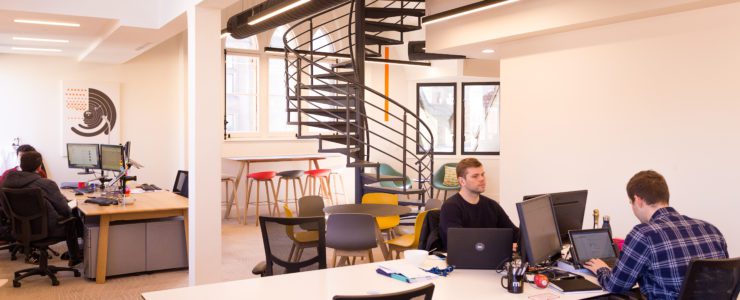
Why coworking is better than working from home
The way we work has been changing dramatically throughout 2020, as more people have worked remotely for the first time in their life.
Figures released by the UK’s Office for National Statistics show 49.2% of employed adults have been working from home this year, in response to the pandemic. This represents a massive leap. Back in 2010, only 691,000 Brits were working remotely, using a phone and computer. In 2020, the figure jumped to 4.2 million.
The question is, where’s the best place to work? Do people thrive when working from home – or are they better off being based in a more flexible office environment?
Homeworking pros and cons
While some people have embraced the changes, others have found working from home isn’t ideal. On the plus side, it has introduced a more flexible working day and allowed people to replace formal workwear with more casual attire.
However, there are negatives too, such as the distractions of working from home. According to research by analytics firm Humanyze, online shopping, gaming and playing with our pets are the main pastimes that divert us from the job in hand.
People are also fitting a nap into their day, leading to changes in working hours. In the regular workplace, employees tend to be available from 9-5, with maybe a break for lunch. Now, as our habits change, on average the working day can be any time between 7am and 7pm, as we’re scheduling in a nap and TV time.
Watching television and streaming movies are major distractions, with Netflix attracting an extra 15.8 million viewers this year. The gaming platform Twitch, where users can watch each other play – has experienced a 20% rise in traffic in 2020.
Some homeworkers are finding it hard to stay focused and have less motivation than in the workplace. Others say they simply find it lonely and this demotivates them. Maintaining a work-life balance is more challenging, as the lines become blurred.
In addition, practical problems, such as a slower broadband connection, can mean video conferencing is often disrupted, as your face suddenly freezes on the screen and colleagues realise your internet speed has dipped – not ideal!
What can coworking offer?
For people reluctant to work from home, there’s a useful option to consider that offers the benefits of an office, in terms of technology, colleagues and a productive environment, combined with the flexibility of homeworking. Of course, we’re talking about coworking.
The main benefits of coworking are productivity, socialising and professionalism. Not having the interruptions of working from home makes coworking a better option in terms of productivity. Once you’re seated in front of your computer, you can carry on working with maximum concentration, making the most of the hours you spend there. Yet should you wish to leave your desk and take a break, you can do so when you choose.
Humans are social animals and the isolation of working from home is one of the most common problems. When coworking, you can constantly communicate with other people, if this is what helps you to stay upbeat. From the reception staff to the other people who use the coworking space, you can interact with people as much, or as little, as you like.
Say goodbye to social isolation and enjoy the buzz of working in an environment surrounded by like-minded individuals. This also enables you to expand your contacts and maybe find opportunities to collaborate on new projects.
Professional environment
The one thing you can’t do when working from home is host professional business meetings for clients. While workplaces are well-versed in practising safety protocols such as social distancing and deep cleaning the premises, your home is never going to look or feel like a professional office.
Even in normal times, it would be almost impossible to host a meeting to an acceptable standard in your home. With coworking space, you can host impromptu meetings at your desk, or use a private meeting room for clients.
The office will already be furnished to a high standard, at no additional cost to the users. Individual desks and chairs, large desks for meetings, comfortable seats in communal areas and the latest equipment, such as printers, come with the territory. This is something you would be hard-pushed to replicate in your home without spending a fortune.
Separating home and work space
The separation of domestic and professional space is extremely important to keep both environments healthy. It’s not possible in all homes to have a separate office, as there simply isn’t enough room, so your workspace may be in your living room, kitchen or bedroom.
Psychologists say in the short term, this can work if you don’t have another option, but over time, it can cause mental health problems. Your mind never really switches off 100% from work. Having your laptop on your dressing table at night just encourages you to check emails, or make a head start on the morning’s work if you can’t sleep. It will also leave you thinking about any problems that have arisen during the day.
When using coworking space, you can arrive home, switch off and chill out, leaving you refreshed and raring to go the next morning. Disconnecting from work is possible, giving you time to recover mentally and physically from the rigours of the day.
Changing attitudes
As a result of changing attitudes and ever-improving technical and network capabilities, the trend for flexible and remote working is projected to increase. Research shows around two-thirds of coworking spaces are planning to expand their premises in the future, with 37% aiming to move into new regions. This is good news for people who are based in coworking spaces, as 70% of them say they feel healthier in this type of environment.
One of the main reasons is that it helps them maintain a good work-life balance. A survey of office workers revealed only 30% wanted a traditional 9-5 working day, with the other 70% preferring the flexibility that coworking offers.
While working from home may seem like a good idea on the surface, people who are feeling distracted, and therefore less productive, may be inspired to try coworking. This way, they can enjoy the benefits of flexible working hours, with fellow workers to bounce ideas off and the latest tech – without the rigidity and expense of a traditional workplace.

![Headspace-dragonstock-Adobe-Stock[1]](https://www.headspacegroup.co.uk/wp-content/uploads/2020/10/Headspace-dragonstock-Adobe-Stock1.jpg)

